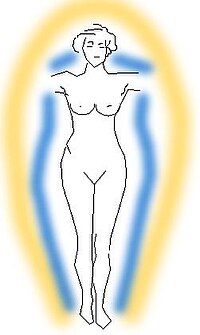 In parapsychology and many forms of spiritual practice, an aura is a field of subtle, luminous radiation surrounding a person or object (like the halo or aureola in religious art). The depiction of such an aura often connotes a person of particular power or holiness. Sometimes, however, it is said that all living things (including humans) and all objects manifest such an aura. Often it is held to be perceptible, whether spontaneously or with practice: such perception is at times linked with the third eye of Indian spirituality. Various writers associate various personality traits with the colors of different layers of the aura.
In parapsychology and many forms of spiritual practice, an aura is a field of subtle, luminous radiation surrounding a person or object (like the halo or aureola in religious art). The depiction of such an aura often connotes a person of particular power or holiness. Sometimes, however, it is said that all living things (including humans) and all objects manifest such an aura. Often it is held to be perceptible, whether spontaneously or with practice: such perception is at times linked with the third eye of Indian spirituality. Various writers associate various personality traits with the colors of different layers of the aura.Skeptics such as Robert Todd Carroll contend that auras may be seen for reasons such as migraines, synesthesi epilepsya, disorder within the visual system, a disorder within the brain, or due to the influence of psychedelic drugs such as LSD. Eye fatigue can also produce an aura, sometimes referred to as eye burn.
- Physical auric body - Physical sensations. Simple physical comfort, pleasure, health.
- The etheric auric body - Emotions with respect to self. Self-acceptance and self love.
- Vital auric body - Rational mind. To understand the situation in a clear, linear, rational way.
- Astral (emotional) body - Relations with others. Loving interaction with friends and family.
- Lower mental auric body - Divine will within. To align with the divine will within, to make commitment to speak and follow the truth.
- Higher mental auric body - Divine love, and spiritual ecstasy.
- Spiritual (intuitive) body - Divine mind, serenity. To be connected to divine mind and to understand the greater universal pattern.

